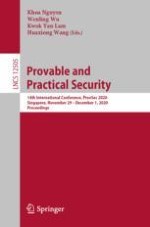2020 | OriginalPaper | Chapter
Key Recovery Under Plaintext Checking Attack on LAC
Authors : Ke Wang, Zhenfeng Zhang, Haodong Jiang
Published in: Provable and Practical Security
Publisher: Springer International Publishing
Activate our intelligent search to find suitable subject content or patents.
Select sections of text to find matching patents with Artificial Intelligence. powered by
Select sections of text to find additional relevant content using AI-assisted search. powered by
